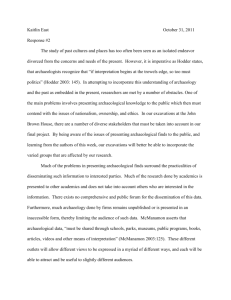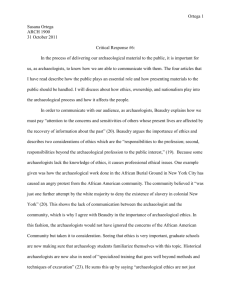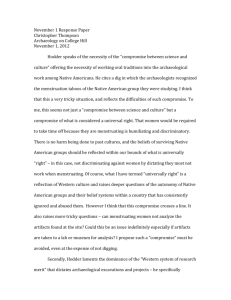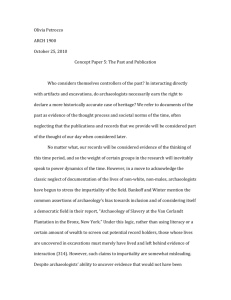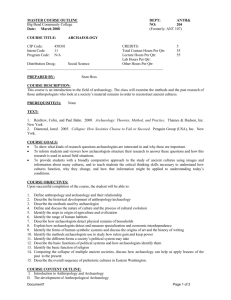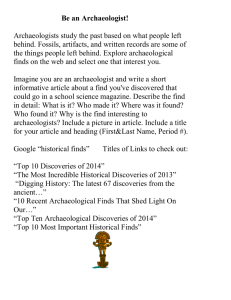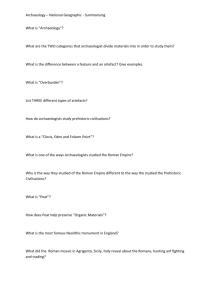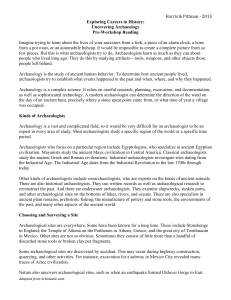Susana Ortega ARCH 1900 31 October 2011 Critical Response #6
advertisement
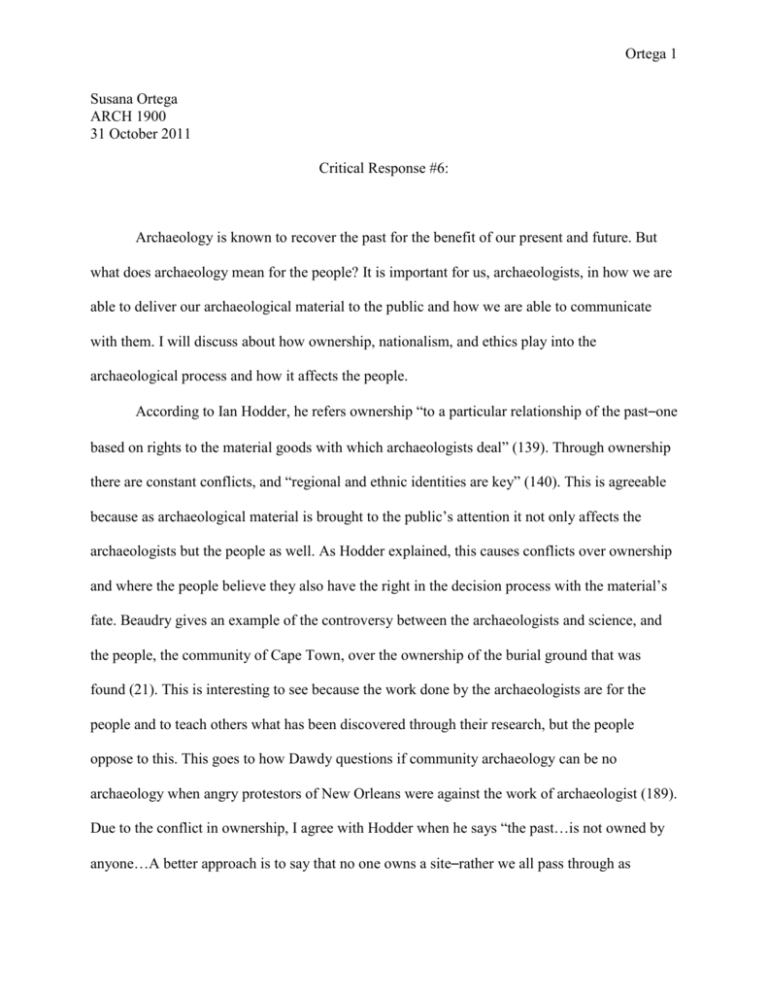
Ortega 1 Susana Ortega ARCH 1900 31 October 2011 Critical Response #6: Archaeology is known to recover the past for the benefit of our present and future. But what does archaeology mean for the people? It is important for us, archaeologists, in how we are able to deliver our archaeological material to the public and how we are able to communicate with them. I will discuss about how ownership, nationalism, and ethics play into the archaeological process and how it affects the people. According to Ian Hodder, he refers ownership “to a particular relationship of the past–one based on rights to the material goods with which archaeologists deal” (139). Through ownership there are constant conflicts, and “regional and ethnic identities are key” (140). This is agreeable because as archaeological material is brought to the public’s attention it not only affects the archaeologists but the people as well. As Hodder explained, this causes conflicts over ownership and where the people believe they also have the right in the decision process with the material’s fate. Beaudry gives an example of the controversy between the archaeologists and science, and the people, the community of Cape Town, over the ownership of the burial ground that was found (21). This is interesting to see because the work done by the archaeologists are for the people and to teach others what has been discovered through their research, but the people oppose to this. This goes to how Dawdy questions if community archaeology can be no archaeology when angry protestors of New Orleans were against the work of archaeologist (189). Due to the conflict in ownership, I agree with Hodder when he says “the past…is not owned by anyone…A better approach is to say that no one owns a site–rather we all pass through as Ortega 2 travelers or tourists (141). This way the past is not owned by anyone, yet it is accessible for all, which is what archaeologists want and to be able to inform to all the public. In McManamon’s article, it describes nationalism as civic similar to citizenship and ethnic, where civic is shared by all the citizens and ethnic is the “individual ethnic heritages” (126). This brings us to local audiences and global audience, where a local can have more of a biological connection with the archaeological material but outsiders who do not have any connection with it can also have an interest to it. McManamon explains this with modern Americans and their interest in the ancient past of America (132). This goes back to Hodder in how the past belongs to no one but travelers or tourists who can have access to it and form some sort of interest and connection to it. McManamon shows this concern in the importance of spreading America’s ancient past to modern Americans through educational systems and mass media tools for those who are not studying (133) In informing our audience we also must be aware of our ethnics. Beaudry describes two considerations of ethnics which are the “responsibilities to the profession; second, responsibilities beyond the archaeological profession to the public interest,” (19). As archaeologists, we must be aware of how we are able to bring information to the public. We must pay “attention to the concerns and sensitivities of others whose present lives are affected by the recovery of information about the past” (20). Beaudry gives an example of the angry protesters who were against the archaeological work done in the African Burial Ground in New York City (20-1). Seeing that ethnics is very important, graduate schools are now making sure that archaeology students familiarize themselves with this. Historical archaeologists are now also in need of “specialized training that goes well beyond methods and techniques of excavation” (23). He sums this up by saying “archaeological ethics are not just about us as archaeologists but are Ortega 3 also about how we behave as professionals and how we relate people who are not archaeologists” (26). So it is our job to connect with the audience or stakeholders and be aware of their concerns as well. Our stakeholders that are relevant in our excavation at the John Brown House would be the Rhode Island Historical Society, Rhode Islanders, and educators. As an archaeologist it is my job to be aware of my stakeholders and how my information will benefit them. I think with our final projects and working for the RIHS, we are able to spread our findings to the community and give access to future students who will take this class. This gives the ownership of all who are interested in the history of the John Brown House and those interested in American history, which the Brown family had its influence to it as well. So in conclusion, we see the importance the relationship between the archaeologist and the public. It is our responsibility to be aware of our audience and not just our intentions as researchers. Ortega 4 Works Cited: Hodder, Ian. 2003. “Sustainable Time Travel: Toward a Global Politics of the Past.” In S. Kane, ed., The Politics of Archaeology and Identity in a Global Contest, 139-147. McManamon, Francis P. 2003. “Archaeology, Nationalism, and Ancient America.” In S. Kane, ed., The Politics of Archaelogy and Identity in a Global Contest, 115-138. Beaudry, Mary. 2009. "Ethical Issues in Historical Archaeology." In The International Handbook of Historical Archaeology, ed. by Teresita Majewski and David Gaimster. Springer, New York, 17-29 Dawdy, Shannon Lee. 2009 "Millennial Archaeology. Locating the Discipline in the Age of Insecurity." Archaeological Dialogues 16, no. 2 (2009): 131-‐42

